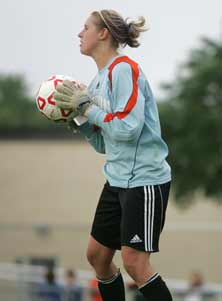
Alissa Viste, left, has to stay aware of scoring threats on the soccer field. Off the field, she has to stay aware of complications from Type-1 diabetes. Nearly one in 400 children in America have Type-1 diabetes.
Photo by Allen Fredrickson
can't let her guard down. She must always be cognizant of her surroundings and stay keenly aware of how she's feeling. If she doesn't, bad things are sure to happen.
It's a fact of life that doesn't just apply to her role as the goalkeeper for one of Wisconsin's top girls soccer teams. It's a fact of life that Viste deals with every day as someone with Type-1 diabetes.
One in every 400 children in America have Type-1 diabetes, according to the American Diabetes Association, and Viste is one of 25.8 million people with the condition. Though balancing the condition with the rigors of being a standout goalkeeper is significant and admirable, it falls a bit short of being called heroic or beating all the odds. And that's a point Viste makes sure to make — that people with diabetes do not have a disease that prevents a normal life and stunts dreams of athletic success.
"You have a disease and you have to take care of yourself, but you can live normally and do what you want. You just have to be a little more careful," she said.

Alissa Viste led Grafton to withinone win of the state final inWisconsin this season.
Photo by Allen Fredrickson
It doesn't take herculean efforts to play sports for those with diabetes. And contrary to what some think, diabetes shouldn't keep kids from playing sports. Doctors W. Guyton Hornsby, Jr., and Robert D. Chetlin state in their article "Management of Competitive Athletes With Diabetes" that exercise is an important tool for most patients.
It doesn't take herculean efforts — but it does require persistent monitoring.
Viste, 17, said she checks her blood sugar numbers about five times per day. On game days, she makes sure to check just before the beginning of the game and once again at halftime. She can't eat whatever she wants whenever she wants, so she has to watch the things she eats and how they affect her blood sugar. Before games she eats proteins to keep her blood sugar high — but not too high.
"When I am on the higher range I don't tend to play my best, I tend to be sluggish and lazy," Viste said, detailing the delicate balance between high and too high. "I've had to push through that a lot of times."
She seemed to push through quite well this year as a junior. Her
Grafton (Wis.) team made it to the Wisconsin Interscholastic Athletic Association Division 1 semifinals Friday before losing to West (Waukesha, Wis.) 4-2 in penalty kicks after a scoreless tie. Grafton finished its season at 24-3-3 with Viste in net. She was an All-North Shore Conference Team pick last year as a sophomore, leading Grafton to the state title game in Division 2.
Viste wears an OmniPod, a device that she fills with insulin at home and then sticks to her skin. The device pricks her with a short needle and begins delivering the flow of however much she needs. A wireless pod, sort of like an iPod, reads and monitors her blood sugar. Another wireless device, called a Continuous Glucose Monitor, can alert her parents and show trends, though she doesn't wear the CGM while she plays.
She's had five hypoglycemic seizures before, so when numbers aren't right, there are grave consequences.
It's second nature for her mother and father to ask her "How are your numbers" and to check on her while she's sleeping. Mike Viste said "We seldom get a good night's sleep straight through. We’re in the habit of being concerned."
Mike knows there is no cure for diabetes and that he isn't the man who is going to discover that cure. He decided he was going to do what he could to help, and that came in the form of riding a bike.
Continue reading
